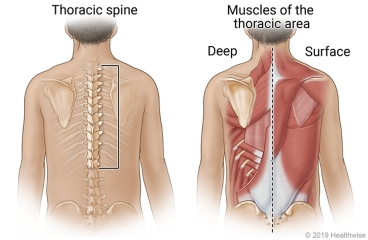
Overview
A back strain happens when you overstretch, or pull, a muscle in your back. You may hurt your back in an accident or when you exercise or lift something. Sometimes you may not know how you hurt your back.
Most back strains will get better with time. You can take care of yourself at home to help your back heal.
Follow-up care is a key part of your treatment and safety. Be sure to make and go to all appointments, and call your doctor if you are having problems. It's also a good idea to know your test results and keep a list of the medicines you take.
How can you care for yourself at home?
- Try to stay as active as you can, but stop or reduce any activity that causes pain.
- You can try using heat or ice to see if it helps.
- Try using a heating pad on a low or medium setting for 15 to 20 minutes every 2 to 3 hours. Try a warm shower in place of one session with the heating pad. You can also buy single-use heat wraps that last up to 8 hours.
- You can also try an ice pack for 10 to 15 minutes every 2 to 3 hours. Put a thin cloth between the ice and your skin.
- Be safe with medicines. Read and follow all instructions on the label.
- If the doctor gave you a prescription medicine for pain, take it as prescribed.
- If you are not taking a prescription pain medicine, ask your doctor if you can take an over-the-counter medicine.
- Try to find a comfortable sleeping position.
- Instead of your regular pillow, you can try a special neck pillow or a rolled-up towel under your neck.
- Try lying on your side with a pillow between your legs. Or lie on your back with a pillow under your knees.
- Return to your usual level of activity slowly.
When should you call for help?
Call 911 anytime you think you may need emergency care. For example, call if:
- You are unable to move an arm or a leg at all.
Call your doctor now or seek immediate medical care if:
- You have new or worse symptoms in your arms, legs, chest, belly, or buttocks. Symptoms may include:
- Numbness or tingling.
- Weakness.
- Pain.
- You lose bladder or bowel control.
Watch closely for changes in your health, and be sure to contact your doctor if:
- You are not getting better as expected.
Where can you learn more?
Go to http://www.healthwise.net/patientEd
Enter U110 in the search box to learn more about "Upper and Middle Back (Thoracic) Strain: Care Instructions".
Current as of: July 24, 2025
Author: Ignite Healthwise, LLC Staff
Clinical Review Board
All Ignite Healthwise, LLC education is reviewed by a team that includes physicians, nurses, advanced practitioners, registered dieticians, and other healthcare professionals.

